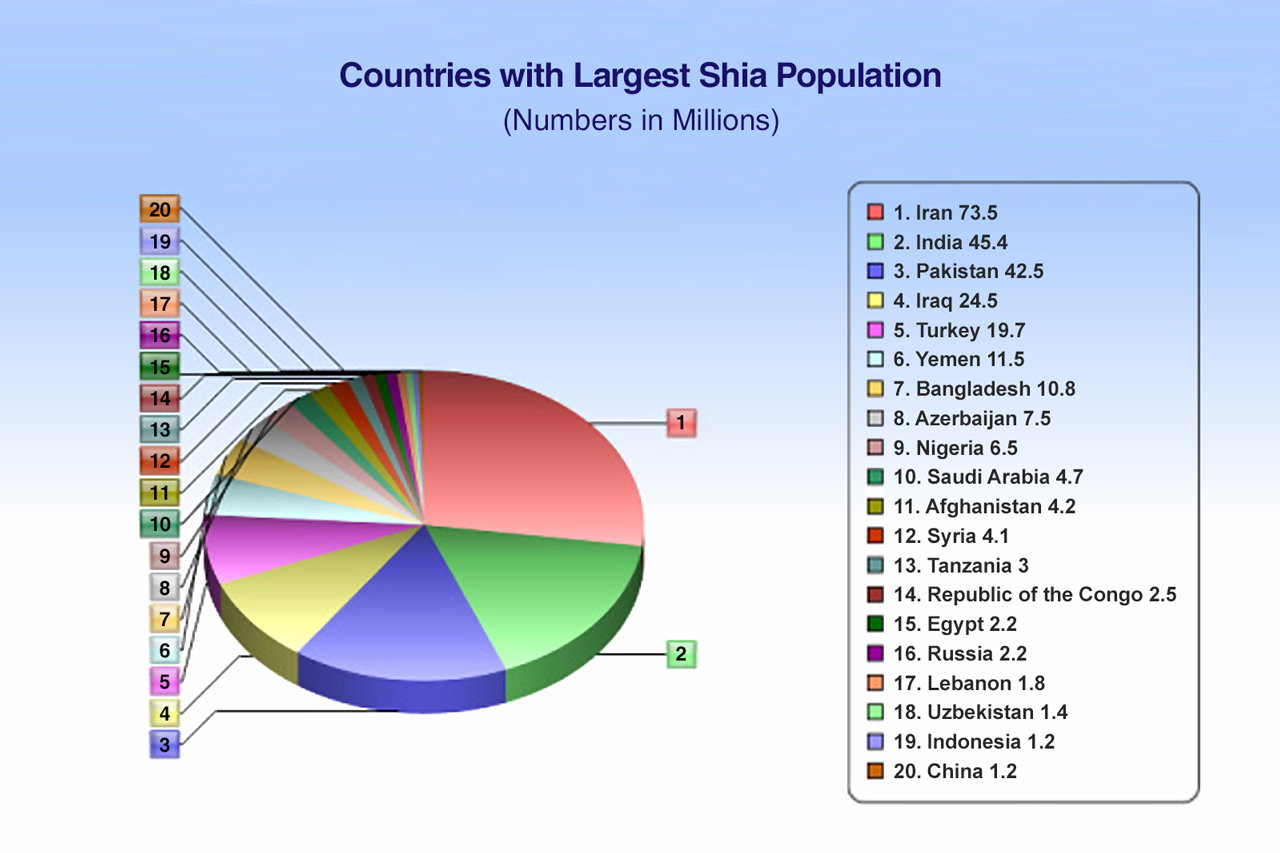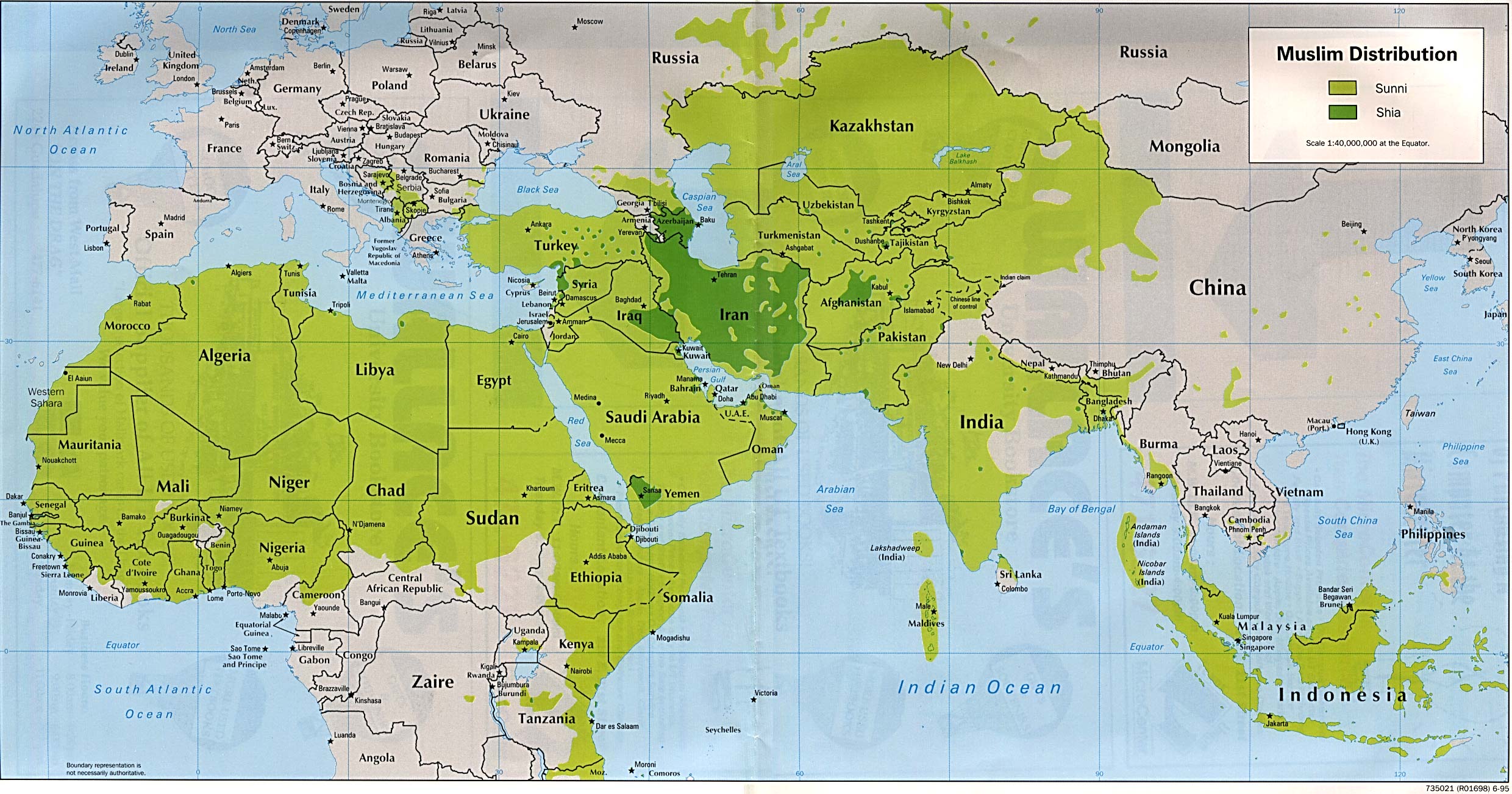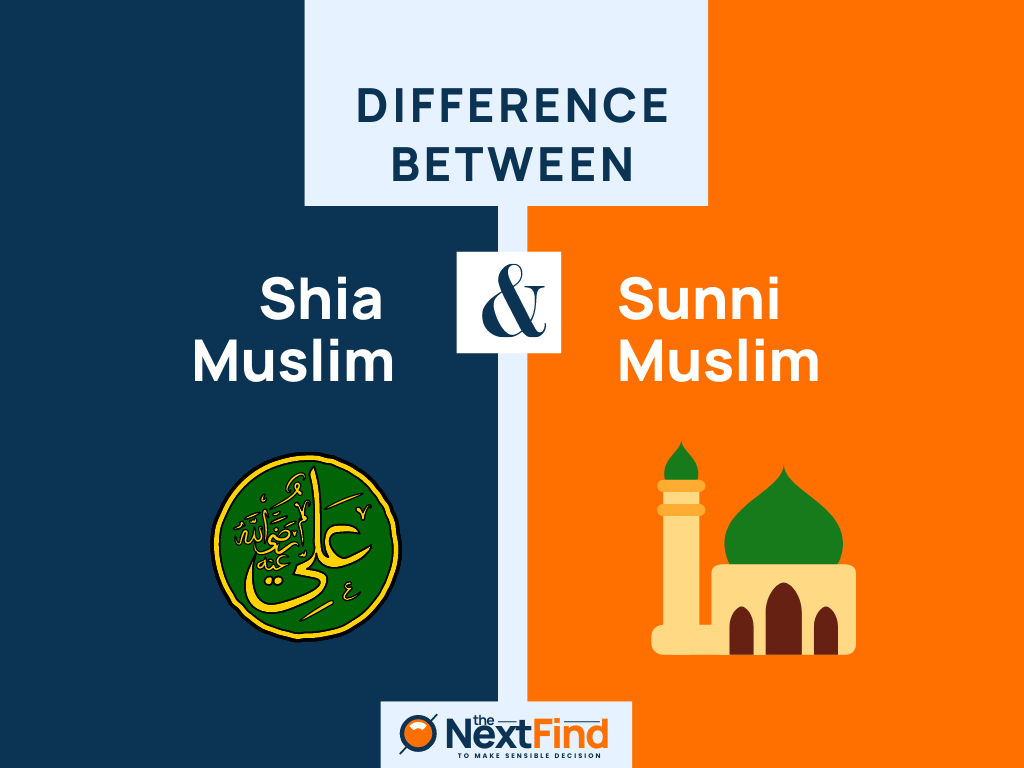Population Of Shia And Sunni Muslim In World - A Look
When we think about the people who make up our big, shared home, it is that fascinating to consider the many different groups and ways of life that exist. The Muslim community, which spreads across so many places on our planet, certainly stands as one of these large groupings of people. It is a faith followed by a great number of individuals, with a rich past and traditions that have shaped cultures far and wide. Knowing a little more about how this community is made up can offer a clearer picture of the world we all share.
Within this wide-ranging Muslim population, there are, you know, two main paths or branches that people generally follow: the Sunni way and the Shia way. These two groups, while sharing a core belief in one God and the teachings of the Prophet Muhammad, do have some distinct ways of doing things and, as a matter of fact, different historical lines of leadership. They represent the biggest parts of the Muslim faith, and their followers live in nearly every corner of the world, making up a truly global presence.
So, what does this mean for the numbers? How many people follow each of these paths, and where do they mostly live? Getting a sense of the population figures for both Shia and Sunni Muslims helps us to, well, better appreciate the sheer scale of their communities and their cultural reach. It is a way of looking at the human fabric of our world, seeing how these groups fit into the bigger picture of global inhabitants, which, quite frankly, is something many people find interesting.
- Molly Noblitt From Ocean Springs A Comprehensive Insight
- Joe Cole The Life And Love Of An Actor His Wife And Family
- Exploring Spidermanvidcon Your Ultimate Resource For Spiderman Content
- Stacie Zabka A Deep Dive Into The Life And Career Of The Talented Actress
- Discover The World Of 300mb Dual Audio Movies A Comprehensive Guide
Table of Contents
- Understanding the Global Muslim Population
- What are the main branches of Islam?
- How large is the Shia population in the world?
- Where do Sunni Muslims primarily live?
- The Distribution of Shia and Sunni Muslim Communities
- Are there countries with a majority Shia population?
- What is the estimated total population of Shia and Sunni Muslims?
- Why is knowing the population of Shia and Sunni Muslims important?
Understanding the Global Muslim Population
The number of people who follow Islam around the world is, honestly, a very considerable figure. We see this faith practiced in nearly every country, from the coldest northern lands to the hottest desert regions. The total count of Muslims makes them one of the largest religious groups on Earth, a fact that really shapes the way societies work in many places. This widespread presence means that when we talk about the global population, Muslims represent a big part of that grand total, a presence that just keeps growing.
This faith has, over a long stretch of time, spread its roots deeply into different cultures and ways of life. So, you find Muslim communities that look very different from one another, depending on where they are. Some live in big, busy cities, while others make their homes in quiet, country areas. Each group, you know, adds its own special flavor to the larger Muslim world, showing how varied and rich this global community truly is. It is a faith that adapts to its surroundings, yet keeps its core beliefs firm.
When we consider the overall count of people on our planet, which, as we hear, recently passed the eight billion mark, it is worth thinking about how many of those individuals are Muslim. This large group of people contributes so much to the world's many ways of doing things, from art and learning to how families live their daily lives. Getting a sense of their numbers is, in a way, like getting a better feel for the whole human family. It helps us see the different pieces that make up the big picture of our shared global home.
- Seo Ye Ji Upcoming Shows 2024 What To Expect From The Talented Actress
- Exploring The Life And Legacy Of Claudeis Newman
- Shameera Aitchison A Comprehensive Look At The Life And Career Of A Rising Star
- Marnie Stevens The Rising Star In The World Of Entertainment
- Jellybean Brains Of Leak Understanding The Phenomenon And Its Implications
What are the main branches of Islam?
Within the broad faith of Islam, there are, basically, two primary paths that people tend to follow. These are known as Sunni Islam and Shia Islam. The split between these two groups happened a very long time ago, not too long after the passing of the Prophet Muhammad. It was, in some respects, a disagreement about who should lead the Muslim community after him. This difference in opinion, over time, grew into two distinct ways of seeing things, each with its own scholars and traditions.
The Sunni path, which is followed by the vast majority of Muslims, believes that the rightful leaders of the community should be chosen by agreement among its members. They hold a great deal of respect for the companions of the Prophet and their actions. This group, you know, makes up somewhere around 85 to 90 percent of all Muslims around the world. Their way of practicing the faith is often seen as the more traditional or common approach, and their teachings spread far and wide.
On the other side, the Shia path believes that leadership should have stayed within the Prophet's family, specifically through his son-in-law, Ali. This belief shapes their views on religious authority and succession. The Shia community, while smaller, is still very substantial, making up roughly 10 to 15 percent of the global Muslim population. They have their own distinct religious practices and holidays, which, naturally, reflect their particular understanding of the faith's history and leadership.
So, while both Sunnis and Shias share the same core beliefs about God and the Prophet, these historical differences have led to, as a matter of fact, separate ways of organizing their religious life and looking at spiritual guidance. It is a bit like different branches of a very old tree, all coming from the same trunk but growing in slightly different directions. These distinctions are what make the Muslim world so rich and, well, quite varied in its expressions.
How large is the Shia population in the world?
When we try to figure out how many people belong to the Shia branch of Islam, we are talking about a significant number, even if it is a smaller portion of the overall Muslim community. Globally, the Shia population is thought to be somewhere in the range of 10 to 15 percent of all Muslims. This means, if we consider the world's total Muslim population, the Shia group amounts to hundreds of millions of people, a truly considerable number, to be sure.
These numbers are, typically, estimates, because getting an exact count of people's religious affiliations can be a bit tricky. People move, governments count in different ways, and sometimes individuals do not openly state their specific branch of faith. However, based on various studies and counts, this percentage range gives us a pretty good idea of their presence. It shows that the Shia community is a very real and active part of the global religious landscape, with followers in many different places.
A large portion of the Shia population lives in the Middle East, particularly in countries like Iran, where they make up the majority. You also find big Shia communities in places like Iraq, Azerbaijan, and Bahrain, where they form a significant part of the people living there. But their presence is not just limited to these areas; there are, of course, noticeable Shia groups in countries like Pakistan, India, Lebanon, and even further afield in parts of Africa and Europe, which is quite something.
So, while they might be the minority branch of Islam, the Shia population is, in fact, a very large and spread-out group of people. Their contributions to culture, learning, and religious thought are considerable, and their communities play an important part in the social fabric of many nations. Knowing about their numbers helps us appreciate the full picture of the Muslim world and the many different ways people live out their faith.
Where do Sunni Muslims primarily live?
The Sunni branch of Islam is, quite frankly, the largest one, representing the vast majority of Muslims across the globe. Because of this, you will find Sunni communities in nearly every country where Islam is practiced. They make up somewhere around 85 to 90 percent of the world's Muslim population, which means their presence is, well, incredibly widespread and covers a great deal of our planet's landmass.
Many countries in the Middle East and North Africa are, typically, home to a Sunni majority. Places like Egypt, Saudi Arabia, Jordan, Syria, and Algeria, for instance, have populations where Sunni Muslims form the overwhelming number of people. These regions are often seen as the heartlands of Sunni Islam, where its traditions and practices have been deeply rooted for many centuries. The faith's influence is very apparent in the daily lives and cultural expressions of these places.
Beyond the Middle East, Sunni Muslims also make up the largest group in many countries across Asia. Indonesia, which has the largest Muslim population in the world, is predominantly Sunni. Pakistan, Bangladesh, Malaysia, and parts of India also have very large Sunni communities. In Africa, countries like Nigeria, Sudan, and many others in the sub-Saharan region are also home to significant Sunni populations, showing just how far this branch of the faith has reached, which is, honestly, quite amazing.
Even in countries where Muslims are a smaller portion of the overall population, such as those in Europe and the Americas, the Sunni tradition is, usually, the more common one among Muslim immigrants and their descendants. This broad distribution means that when we talk about the global Muslim presence, we are, more or less, talking about the Sunni population in many places. Their way of life, their places of worship, and their cultural practices shape a very big part of the world's human story.
The Distribution of Shia and Sunni Muslim Communities
Looking at where Shia and Sunni Muslims live around the world shows us a really interesting pattern of human settlement and historical movement. While Sunni communities are, generally, found almost everywhere, Shia communities tend to be more concentrated in certain areas. This distribution is not just random; it has a lot to do with historical events, migrations, and how faith has spread over many centuries. Knowing about these patterns gives us a better picture of the world's people.
For example, you will find that the highest numbers of Shia Muslims are clustered in specific countries, which, you know, makes those places quite distinct in the broader Muslim world. On the other hand, the vast majority of nations with a Muslim presence will have a Sunni majority. This contrast in how these two groups are spread out tells a story about their past and how their communities have grown and developed over time. It is a bit like seeing different colors on a map, each showing where a particular group of people has made their home.
Understanding this geographical spread is, in a way, helpful for anyone trying to get a grip on global affairs or just wanting to learn more about different cultures. It shows that even within a single faith, there can be varied ways of living and different places where specific traditions are very strong. The way these populations are laid out across the continents, honestly, offers a unique window into the human story.
Are there countries with a majority Shia population?
Yes, there are, in fact, a few countries where the Shia population forms the largest group of people, making them distinct in the Muslim world. The most well-known example is Iran, where the Shia faith is the official state religion and the vast majority of its citizens follow this path. Iran stands as a very central place for Shia Islam, influencing many other Shia communities around the globe, which is, really, quite significant.
Another country where Shia Muslims are the majority is Iraq. While Iraq has a mixed population, the Shia community makes up the largest segment of its people. This has, naturally, shaped the country's history and its current social and political landscape. The holy cities within Iraq are also very important pilgrimage sites for Shia Muslims from all over the world, drawing many visitors each year.
Beyond these two, Bahrain also has a population where Shia Muslims are thought to be the majority, though this is sometimes a point of discussion. In other places, like Azerbaijan, a significant portion of the people are Shia, even if the country itself is officially secular. You also find areas within countries, for example, in Lebanon, where Shia Muslims form a very strong and noticeable community, often concentrated in particular regions.
So, while Sunni Muslims are found in greater numbers across more countries, these few nations and specific regions stand out as places where the Shia branch of Islam is, basically, the dominant way of life for the majority of the people. This concentration gives these areas a distinct character and, you know, makes them central to the Shia world. It shows how different parts of the Muslim faith have found their main homes in particular parts of the world.
What is the estimated total population of Shia and Sunni Muslims?
Trying to get an exact count of the total population for both Shia and Sunni Muslims worldwide can be, honestly, a bit like trying to count grains of sand on a beach. It is a very big number, and precise figures are hard to come by. However, based on various studies and reports from different organizations, we can arrive at some very good estimates that give us a clear picture of their sizes. These numbers, you know, help us see the sheer scale of these communities.
If we consider the global Muslim population to be somewhere around 1.8 to 2 billion people, which is a figure often mentioned, then we can start to break that down. The Sunni population, making up about 85 to 90 percent of this total, would mean there are, roughly, between 1.5 billion and 1.8 billion Sunni Muslims around the world. This truly vast number highlights their widespread presence and influence in so many different parts of the globe.
For the Shia population, which is estimated to be about 10 to 15 percent of the total Muslim community, the numbers would then fall somewhere between 180 million and 300 million people. This is, by any measure, a very large group of individuals, making them one of the biggest religious minorities globally, even if they are a minority within the broader Muslim faith. Their numbers show a significant and active presence in many countries.
These figures, it is worth remembering, are estimates and can change over time due to births, deaths, and migrations. But they do give us a very good sense of the relative sizes of these two major branches of Islam. They show that while one group is much larger, the other still represents a considerable portion of the world's people, with a rich and varied cultural life. It is, basically, a look at the sheer human scale of these communities.
Why is knowing the population of Shia and Sunni Muslims important?
Knowing about the population numbers of Shia and Sunni Muslims is, in a way, something that helps us better understand the world we live in. It is not just about raw figures; it is about seeing the human stories behind those numbers. When we have a grasp of where these communities live and how many people are part of them, it gives us a clearer view of cultural patterns, social structures, and even, well, some of the historical events that have shaped different regions.
For example, in countries where both Sunni and Shia communities live side by side, understanding their relative sizes can help explain certain social dynamics or political landscapes. It shows how different groups contribute to the overall fabric of a nation. This knowledge is, naturally, a part of what helps people get along better, fostering a bit more appreciation for different ways of life and belief systems.
Beyond just numbers, this information helps us recognize the vast diversity within the Muslim faith itself. It reminds us that there is no
- Exploring The Life And Achievements Of Ranjeeta Kaur
- How Much Do Matt And Abby Howard Make An Indepth Analysis
- Pippa Grandison A Comprehensive Look Into Her Life And Career
- How Much Does Jonathan Roumie Get Paid For The Chosen
- Who Is Andrew Weissmanns Wife A Deep Dive Into Their Life Together

World Shia Muslim Population – Islamic Research and Information Center

Understanding Islamic Sects: Sunni, Shi'a and Sufi

20+ Differences Between Shia Muslim And Sunni Muslim (Explained)